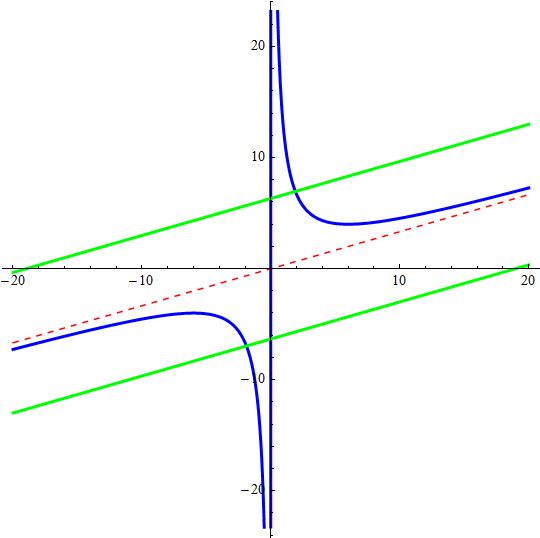The point #P(alpha,beta)# lies on the curve #C# with equation #f(x)= 1/3x+12/x# such that #alpha>0, alpha≠6#. The normal at #P# only crosses #C# once. How do I find the exact value of #alpha#?
3 Answers
There is no such point
Explanation:
Explanation:
The gradient of the tangent to a curve at any particular point is given by the derivative of the curve at that point. The normal is perpendicular to the tangent so the product of their gradients is
We have:
# f(x) = x/3+12/x \ \ \ \ ..... (star)#
# " " = (x^2+36)/(3x) #
First we find the coordinate
# beta = f(alpha) #
# \ \ = (alpha^2+36)/(3alpha) #
Then differentiating
# f'(x) = 1/3-12/x^2 #
# " " = (x^2-36)/(3x^2) #
So at the point
# m_T = f'(alpha) #
# " " = (alpha^2-36)/(3alpha^2) #
Hence, the gradient of the normal at
# m_N = -1/m_T #
# " " = -1/((alpha^2-36)/(3alpha^2)) #
# " " = -(3alpha^2)/(alpha^2-36) \ \ \ \ because alpha != 6#
So the normal passes through
# y-beta = -(3alpha^2)/(alpha^2-36) (x - alpha) #
# :. y= (3alpha^2(alpha-x))/(alpha^2-36) + (alpha^2+36)/(3alpha) #
# :. y= (9alpha^3(alpha-x) + (alpha^2+36)(alpha^2-36))/((3alpha)(alpha^2-36)) #
# :. y= (9alpha^4-9alpha^3x + alpha^4-1296)/((3alpha)(alpha^2-36)) #
# :. y = (10alpha^4-9alpha^3x -1296)/((3alpha)(alpha^2-36)) #
This normal at
# { (y = (x^2+36)/(3x), "(The Function)" ), ( y = (10alpha^4-9alpha^3x -1296)/((3alpha)(alpha^2-36)), "(The Normal)" ) :} #
i.e. a solutions of:
# (x^2+36)/(3x) = (10alpha^4-9alpha^3x -1296)/((3alpha)(alpha^2-36)) #
# :. (x^2+36)/(x) = (10alpha^4-9alpha^3x -1296)/(alpha^3-36alpha) #
# :. (x^2+36)(alpha^3-36alpha) = (10alpha^4-9alpha^3x -1296)x #
# :. alpha^3x^2-36alphax^2+36alpha^3-1296alpha = 10alpha^4x-9alpha^3x^2 -1296x #
# :. alpha^3x^2-36alphax^2+36alpha^3-1296alpha - 10alpha^4x+9alpha^3x^2 +1296x =0#
# :. (10alpha^3-36alpha)x^2 + (1296- 10alpha^4)x+(36alpha^3-1296alpha) = 0#
# :. (5alpha^3-18alpha)x^2 + (648- 5alpha^4)x+(18alpha^3-648alpha) = 0#
This is a quadratic in
- one repeated real solution
- two unique real solutions
- two complex solutions
We want our Normal to touch the original curve just once, and therefore we require one repeated real solution, and so the discriminant,
# (648- 5alpha^4)^2-4(5alpha^3-18alpha)(18alpha^3-648alpha) = 0#
# :. 419904-6480alpha^4+25alpha^8 - 4(90alpha^6-3240alpha^4-324alpha^4+11664alpha^2) = 0#
# :. 419904-6480alpha^4+25alpha^8 -360alpha^6+14256alpha^4-46656alpha^2 = 0#
# :. 25alpha^8-360alpha^6+7776alpha^4-46656alpha^2 +419904= 0#
# :. (5alpha^4-36alpha^2+648)^2= 0#
# :. 5alpha^4-36alpha^2+648= 0#
And for this quadratic equation in
# Delta = (-36)^2-4(5)(648) #
# \ \ \ = 1296-12960 #
# \ \ \ = -11664 #
# \ \ \ < 0 #
There are no real solutions for
Thus the premise of the original question is false, and there is no such point
Explanation:
The function
Building a normal line in the positive-right leaf, we have a point which is it's minimum point, such that the normal does intersect
The only non intersecting normal for
or
or
so for
The normal equations are then
So, we can construct four normal lines which do not intersect the other leaf. The verticals and the slanted.
Attached a plot showing the normal lines at

See below.
Explanation:
Another approach.
Defining
we have
so the normal line passing by
Now doing
So we have the two potential intersections within the normal and the function
One of them is obviously for
must be not a real number. This is satisfied when
so there are solutions located at


